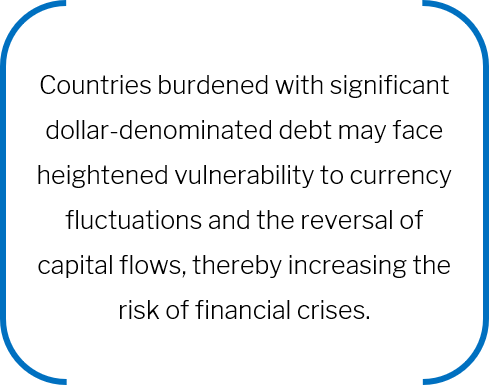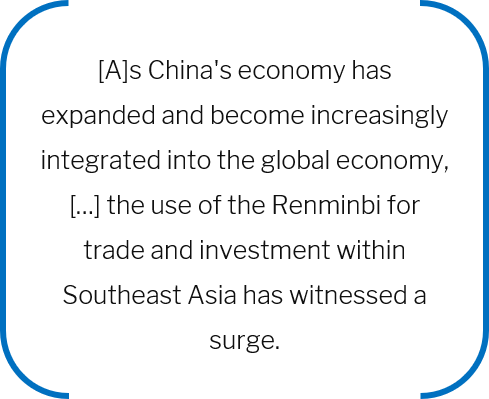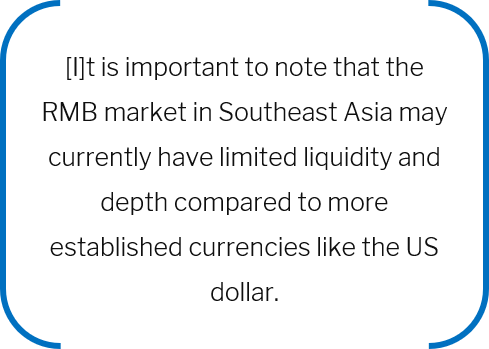Author: Prateek Gupta, Integrated Programme in Management, IIM Indore
Southeast Asia, comprising diverse economies, is a rapidly evolving and dynamic region on the global stage. Demonstrating resilience amidst global uncertainty, it has emerged as an economic powerhouse. Overcoming challenges such as the COVID-19 pandemic, the Russia-Ukraine War, and the global economic slowdown, Southeast Asia has established itself as a prominent center for global trade and investment. The countries encompassing this region include Indonesia, Malaysia, the Philippines, Thailand, Vietnam, Brunei, Singapore, Cambodia, Laos, Myanmar, among others. Projections indicate that the economy of the ASEAN-10 countries is expected to achieve a growth rate of 5.6% in 2022, 4.6% in 2023, and 4.8% in 2024, on average.
At the moment, the Southeast Asian region heavily relies on the US Dollar (henceforth USD) as its primary foreign currency. A significant portion, exceeding 80%, of the outstanding international debt securities within Southeast Asia are denominated in dollars. Moreover, between 2015 and 2020, the majority of cross-border payments to, from, and within the region were conducted in dollars, solidifying the currency’s predominant role in Southeast Asian trade payments and financial markets. For intra-regional cross-border payments, Southeast Asia typically utilizes accounts held by members of the Clearing House Interbank Payments System (CHIPS), headquartered in New York. In 2021 alone, CHIPS settled nearly $1.8 trillion in daily dollar payments, further emphasizing the region’s dependence on the dollar. Due to the underdeveloped nature of regional currency pair markets, separate transactions involving each currency against the dollar are executed to facilitate conversions between different regional currencies.

The Dominance of US Dollar: Reasons
The dominance of the USD as a global reserve currency can be attributed to several factors. First, the US economy enjoys a high level of trust and confidence worldwide, primarily due to its deep and highly liquid financial markets. Boasting the largest economy globally, with a staggering real GDP of $20.94 trillion dollars, the United States holds a prominent position. Interestingly, although the US economy represents only a quarter of the global economy, approximately 60% of the world’s foreign reserves are denominated in USD. Second, the USD holds the status of being the most preferred medium of exchange in international trade and finance. Despite the Euro’s dominance outside of Europe, nearly 70% of exports are invoiced in USD. Moreover, as stated in a report by the Asian Development Bank, between 80 and 90 per cent of exports from Southeast Asian countries are invoiced in USD. Lastly, the historical perception of the USD as a stable currency has also played a significant role in its global prominence. Its stability and widespread acceptance make it an attractive choice for international transactions, trade, and investment. Between 2010 and 2022, it is evident that the value of the USD has appreciated by approximately 44%. These factors collectively contribute to its enduring dominance as the global reserve currency.
Emerging Challenges and Motivations for Change
Concerns regarding the dependence on the USD have prompted officials and policymakers in Singapore, Malaysia, Indonesia, and Thailand to announce measures aimed at reducing their reliance on the USD, particularly in intra-regional trade payments. Several factors contribute to their apprehension. First, these countries are wary of the potential economic repercussions resulting from the tightening of US monetary policy. Such tightening measures could have a significant impact on the region, making it vulnerable to fluctuations in US monetary policy that may not align with their domestic economic conditions. For example, numerous nations heavily reliant on the USD encounter challenges in reducing inflation within their own economies, primarily attributed to the strong nature of the USD. This susceptibility to external monetary policy adjustments raises concerns about potential spillover effects. Additionally, the dominant status of the USD as a reserve currency, grants the United States a degree of authority and power in influencing a country’s choice of trading partners. This influence is exemplified by the sanctions imposed on Russia following the Russia-Ukraine war, which have hindered the ability of several countries to engage in transactions with Russia.
Moreover, the United States enjoys the privilege of maintaining large current account deficits and accumulating substantial debt. Such imbalances and economic instability within the US can have repercussions on the region. Countries burdened with significant dollar-denominated debt may face heightened vulnerability to currency fluctuations and the reversal of capital flows, thereby increasing the risk of financial crises. In September 2022, the debt rose up to its all-time high, $30.93 trillion. This is extremely deleterious for the economies in the region. Taken together, these concerns drive the efforts of Southeast Asian countries to mitigate their dependence on the USD and safeguard their economic stability. As a result, there is a growing interest in non-dollar financial channels in the region. China sees these challenges and motivation as an opportunity to push the Renminbi as an alternative to the USD – and eventually to make it the dominant global reserve currency.

The Rise of the Renminbi (RMB) in Southeast Asia
The RMB is progressively gaining prominence in trade and investment activities within Southeast Asia, signifying a notable shift in currency preferences. Broadly seven factors contribute to this growing adoption of the RMB. First, as China’s economy has expanded and become increasingly integrated into the global economy, the RMB has attained recognition as a significant international reserve currency. Consequently, the use of the RMB for trade and investment within Southeast Asia has witnessed a surge, leading many countries in the region to accumulate substantial reserves of the Chinese currency. A noteworthy development took place in June 2022, as the central banks of Singapore, Malaysia, and Indonesia renewed an emergency liquidity arrangement initiated by the People’s Bank of China (PBOC). This arrangement, funded by the RMB, provides a mechanism for Central Banks in times of market stress. Its existence is anticipated to foster greater intra-regional utilization of the Renminbi and facilitate enhanced financial integration.
Second, the escalating economic influence of China in Southeast Asia, coupled with its endeavours to establish the Renminbi as a global currency, serves as another impetus for the rising adoption of the Renminbi in the region. China has facilitated this process by opening up its domestic market to numerous foreign financial institutions, thereby fostering the use of the Renminbi on a global scale. Third, one of the key factors driving the appeal of the Renminbi in Southeast Asia is its demonstrated stability amidst the substantial depreciation experienced by other major currencies. This stability has bolstered confidence in the Renminbi as a reliable and resilient currency for trade and investment activities within the region. As of April 2023, China’s foreign exchange reserves have increased to USD 3.205 trillion, surpassing market expectations of USD 3.192 trillion. According to data from the International Monetary Fund (IMF), the USD’s share dropped to 58.4% by the end of Q4, which marks the lowest share of global reserve currencies held in dollars since 1994.
Fourth, the imposition of sanctions by Western nations against Russia in response to the Ukraine war conflict has expedited the internationalization of the RMB. These sanctions have prompted countries to seek alternative currencies for conducting international transactions, and the RMB has emerged as a viable option.
Fifth, the rise of the RMB in Southeast Asia has been further bolstered by a series of initiatives specifically designed to promote the adoption of the Chinese currency. Notably, the China-led Belt and Road Initiative has served as a crucial platform for expanding the usage of the Renminbi in infrastructure projects throughout the region. This initiative has facilitated increased transactions in the Chinese currency, thereby enhancing its prominence in Southeast Asia. Additionally, the establishment of Renminbi-denominated bond markets has played a significant role in facilitating businesses’ access to financing in the Renminbi. This development has simplified the process of obtaining funding in the Chinese currency, further promoting its utilization in the region. Furthermore, the Chiang Mai Initiative (CMI) merits attention as a notable multilateral currency swap arrangement among the ten member countries of the Association of Southeast Asian Nations (ASEAN). The CMI has contributed to addressing the short-term liquidity difficulties in the region and to supplementing the existing international financial arrangements.
Sixth, China has undertaken significant measures to promote the international use of the RMB by removing restrictions on its usage in current account transactions and gradually expanding its scope in capital account transactions. Notably, under the capital account, China has broadened the sources of offshore funds, allowing Chinese enterprises to make overseas direct investments in RMB since 2011. Furthermore, recent regulations have facilitated offshore lending by mainland banks, thereby facilitating the flow of RMB across borders. To further support the internationalization of the RMB and provide a contingency source of liquidity, the People’s Bank of China (PBoC) has established bilateral local currency swap facilities with overseas central banks and monetary authorities. These arrangements aim to facilitate the use of the RMB in international transactions and ensure the availability of liquidity when needed.
Seventh, the ascent of the Renminbi (RMB) can be attributed to its inclusion in the International Monetary Fund’s (IMF) Special Drawing Rights (SDR) basket of currencies on October 1, 2016. This significant development facilitated China’s deeper integration into the global financial system. Moreover, the inclusion bolstered the credibility of the RMB, as other countries began to shed their reservations and recognize it as a freely usable currency. This event symbolized China’s expanding presence in global trade and subsequently led to a substantial surge in the international use and trading of the RMB.
According to a report by Reuters, in March 2023, the RMB has surpassed the USD to become the most widely-used currency for cross-border transactions in China. The data shows that the RMB accounted for 48.4% of all cross-border transactions, while the dollar’s share declined from 48.6% in the previous month to 46.7%. This indicates a shift in the usage of currencies for international transactions in China, with the RMB gaining prominence in cross-border trade. There are also both positive and negative impacts of adopting RMB as a reserve currency on the Southeast Asian region.

Impact of the adoption of RMB as a reserve currency on Southeast Asian countries
The adoption of the RMB as a reserve currency can have several notable impacts on Southeast Asian countries. First, given that China serves as a significant trade partner for most Southeast Asian countries, the adoption of the RMB as a reserve currency can streamline trade transactions between them. This simplification can lead to reduced currency exchange costs and mitigate foreign exchange risks. Consequently, bilateral trade can be bolstered, fostering stronger economic ties. As a result, there will likely be an increase in cross-border RMB usage and cross-border RMB settlement.
Second, the adoption of the RMB can facilitate the objectives of the Regional Comprehensive Economic Partnership (RCEP) agreement, which was signed in 2020. By embracing the RMB, Southeast Asian countries can enhance economic integration with China and other participating nations.
Third, inclusion of the RMB in currency reserves can diversify the holdings of Southeast Asian economies, reducing reliance on a single currency. Such diversification enhances resilience to currency volatility and provides a hedge against external shocks.
Fourth, adopting the RMB can provide Southeast Asian businesses and investors with access to RMB funding sources, such as offshore RMB bond markets. This expanded access to financing options and investment opportunities in China allows for greater diversification and financial flexibility.
Fifth, it is important to note that the RMB market in Southeast Asia may currently have limited liquidity and depth compared to more established currencies like the USD. This can present challenges in areas such as pricing, hedging, and accessing sufficient RMB liquidity for trade and investment needs.
Sixth, embracing the RMB as a major currency could have geopolitical ramifications for Southeast Asian economies. These nations must exercise caution in managing their interactions with other major global powers, ensuring a delicate equilibrium between their economic priorities and political dynamics.

Conclusion
This research paper examined Southeast Asia’s gradual shift away from the USD towards the Renminbi (RMB) and its potential implications. The RMB’s growing importance in Southeast Asian trade and investment is driven by factors such as increased trade with China, currency swap agreements, and the establishment of RMB clearing centres. Adopting the RMB as a major currency offers advantages in trade facilitation, access to RMB funding sources, and regional financial integration. However, the adoption of the RMB faces challenges related to economics, geopolitics, and trust. While the economics and geopolitics support the RMB’s rise, there is still a level of scepticism and hesitation due to trust concerns associated with China. The trajectory of Southeast Asia’s shift and the role of the RMB will be influenced by factors such as internationalization pace, market development, regulations, and geopolitical dynamics. Ongoing monitoring, collaboration, and adaptable strategies are essential to maximize benefits and manage risks with respect to the Southeast Asian Region. In conclusion, the feasibility and impact of the RMB taking centre stage in Southeast Asia depend on effective implementation, regional cooperation, and a balanced approach. With careful planning, coordination, and trust-building efforts, the adoption of the RMB can enhance trade, investment, financial stability, and regional economic integration, bolstering Southeast Asia’s position in the evolving global economy.